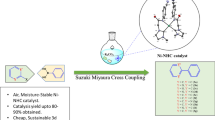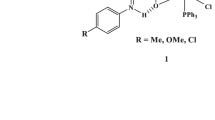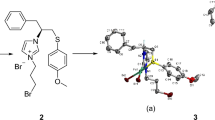Summary
The synthesis and characterization of two new ligands derived from the 1:1 and 1:2Schiff base condensation of benzoylacetylacetone with N-benzylethylenediamine as well as some of their metal complexes are reported. The 1:1Schiff base1 is a potential tetradentate, binucleating ligand with two adjacent coordination sites NNO(X) (X=Cl, NO3) and OO(XY), whereX andY are exogenic donor atoms. The reaction of1 with PdCl 2−4 affords a mononuclear, square-planar complex3a with the metal atom coordinated to the NNO site of1 and to Cl−. The X-ray structure of this complex shows that the coordination of the Pd atom by an NNO (Cl) moiety reduces the available space in OO(XY) site for coordinating another metal atom; moreover, the small distance between the two oxygen atoms of the “hard base” site OO(XY) suggests the presence of hydrogen bonding and therefore this proton is not easily displaced by a typical soft acid such as Pd2+. When the same ligand reacts with Ni(II) or Cu(II) nitrates, again only mononuclear complexes3b and3c are obtained with the same donor atoms as for the Pd(II) complex but withX=NO3. The 1:2Schiff base4, a potentially binucleating ligand with two non-equivalent coordination sites NNO(X), was not isolated as a free ligand. However, it gave the binuclear Hg(II) complex5 by the reaction of benzoylacetylacetone and N-benzylethylenediamine in the presence of HgCl2.
Zusammenfassung
Es wird über die Synthese und Charakterisierung von zwei neuen Liganden, die durch Kondensation von Benzoylacetylaceton und N-Benzylethylendiamin im Molverhältnis 1:1 und 1:2 entstehen, sowie über die Bildung einiger ihrer Metallkomplexe berichtet. DieSchiffsche Base1 (1:1) ist ein potentieller tetradentater, zur Bildung von Zweikernkomplexen geeigneter Ligand, der über zwei benachbarte Koordinationsbereiche NNO(X) (X=Cl, NO3) und OO(XY) verfügt, wobeiX undY exogene Donoratome repräsentieren. Die Reaktion von1 mit PdCl 2−4 gibt den planarquadratischen Einkernkomplex3a, dessen Metallion von einer NNO-Umgebung und Cl− koordiniert ist. Die Röntgenstrukturanalyse von3a zeigt, daß durch die Koordination des Pd-Ions kein Raum für die Koordination eines zweiten Metallions mit OO(Y, Y)-Umgebung zur Verfügung steht. Vielmehr kommt es zur Ausbildung einer Wasserstoffbrückenbindung, dessen Proton durch eine typische “weiche Säure”, wie Pd2+, nicht verdrängt wird.1 reagiert mit Ni(II)- und Cu(II)-nitrat, wobei wieder nur einkernige Komplexe (3b, c) entstehen (X=NO3). DieSchiffsche Base4 ist ein potentieller Ligand für Zweikernkomplexe.4 entsteht als zweikerniger Hg(II)-Komplex5 bei der Umsetzung von Benzoylaetylaceton und dem Amin in Gegenwart von HgCl2.
Similar content being viewed by others
References
Casellato U., Vigato P. A., Fenton D. E., Vidali M. (1979) Chem. Soc. Rev.8: 199
Glick M. D., Lindvedt R. L. (1976) Prog. Inorg. Chem.21: 233
Fenton D. E. (1983) Adv. Inorg. Chem. Radiochem.2: 187
Kwiatkowski M., Kwiatkowski E., Olechnowicz A., Ho D. M., Deutsch E. (1988) Inorg. Chim. Acta150: 65
Wallis W. N., Cummings S. C. (1974) Inorg. Chem.13: 991
Gutiérrez J. A., Zarraga M. C., Mendoza G. (1993) J. Coord. Chem.28: 305
Cea Olivares R., Gutiérrez A., Rodríguez I. (1986) Bol. Soc. Quím. Perú52: 14
Kwiatkowski, M., Kwiatkowski E., Olechnowicz, A., Ho D. M., Deutsch E. (1990) J. Chem. Soc. Dalton Trans 2497
Cea Olivares R., Gutiérrez A. (1986) Inorg. Chim. Acta118: 85
Angelici R. J. (1977) Synthesis and Technique in Inorganic Chemistry, 2nd ed. Sanders, Philadelphia, p 213.
Sagara F., Kobayashi H., Ueno K. (1973) Bull. Chem. Soc. Japan46: 484
Hoskins, B. F., McKenzie C. J., Robson R. (1992) J. Chem. Dalton Trans. 3083
Brodersen, K., Hummel H., (1987) In: Wilkinson G. (ed) (1987) Comprehensive Coordination Chemistry, Vol. 5, 1st ed. Pergamon Press, Oxford, p 1061
Author information
Authors and Affiliations
Rights and permissions
About this article
Cite this article
Gutiérrez, J.A., López-Jiménez, J.A., Gaviño, R. et al. Synthesis and characterization ofSchiff bases derived from 1:1 and 1:2 condensations of benzoylacetylacetone with N-benzylethylenediamine. Complexes with some divalent metal ions. Monatsh Chem 126, 505–518 (1995). https://doi.org/10.1007/BF00807423
Received:
Accepted:
Issue Date:
DOI: https://doi.org/10.1007/BF00807423




